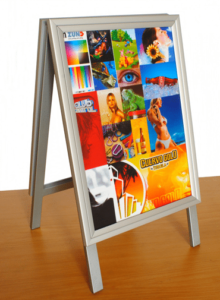In today’s competitive marketplace, where digital noise often dominates our attention, the power of effective signage can sometimes be underestimated. However, businesses that harness the potential of well-crafted signs are poised to stand out in bustling environments, capturing not only attention but also interest and intrigue. Signage serves as a crucial touchpoint between a brand and its audience, offering a visual narrative that speaks volumes about identity and purpose without uttering a single word.
Effective signage plays an indispensable role in elevating brand visibility, acting as both a beacon for existing customers and an invitation to new ones. With strategic placement and thoughtful design, signs have the capability to cut through cluttered visuals and communicate messages clearly and immediately. By crafting engaging signage that resonates with your target audience, businesses can enhance customer engagement significantly—transforming passersby into loyal patrons over time. As we delve deeper into this article, discover how deploying strategic signage can catalyze business success by improving recognition, increasing foot traffic, and boosting sales effortlessly.
Enhancing Brand Recognition through Effective Signage
Consistent signage plays a crucial role in establishing a strong brand identity, ensuring that businesses stand out in an increasingly competitive marketplace. With well-designed signage, business owners can communicate their brand’s values and personality succinctly to passerby, creating a lasting impression. Take global franchises like Starbucks or McDonald’s, for instance. Everywhere you go, the uniform design elements such as logos, colours, and iconography make their stores instantly recognizable. This consistency helps to build familiarity and trust among consumers.
The use of colour, typography, and design are essential in crafting signage that is not only attractive but also memorable. Each element should be carefully chosen to resonate with the target audience while aligning with the overall brand image. For example, tech companies often opt for sleek fonts and minimalist designs that convey innovation and modernity. Meanwhile, children’s brands might select playful colors and whimsical typefaces to appeal to younger demographics. It’s important for businesses to use their signature style consistently across all signs to reinforce brand presence.
Strategically placing your logo within signage further enhances customer recall. The logo should occupy prime real estate on the sign where it is most visible—the top corner or center of a sign are often ideal placements for maximum impact. An effectively positioned logo not only reinforces recognition but can also serve as a mental cue prompting customers to engage with the brand repeatedly over time. In retail settings especially, when shoppers see familiar logos in promotional materials or storefront displays, it can trigger positive associations they’ve developed over previous interactions.
Overall, leveraging consistent signage with deliberate attention to color schemes, typographical choices, design coherence, and strategic logo placement significantly boosts brand recognition efforts. Such well-planned visual cues ensure that your business remains top-of-mind among consumers who encounter your signs amidst myriad other competing stimuli they encounter daily.
Increasing Customer Foot Traffic
Eye-catching signs can be a powerful tool for attracting new customers to your business. An effectively designed sign not only captures attention but also conveys the business’s core message quickly and clearly. For example, a well-crafted storefront sign with vibrant colors and bold typography could entice passersby into a café for their morning coffee. This visual allure is particularly crucial in high-traffic areas where businesses compete for attention amidst a sea of competing visuals. Thus, investing in visually appealing signage can create an inviting impression that turns pedestrians into potential customers.
Location-based strategies play a critical role in maximizing the visibility of signage and, ultimately, the foot traffic to your business. Placing signs at strategic points—such as near busy intersections or public transport hubs—ensures they reach a wider audience who might not have initially planned to visit your establishment. For instance, directional signs leading from a subway exit to your retail store can help guide interested parties directly to you. Furthermore, altering signage placement based on analytics regarding high-traffic routes around your area may enhance effectiveness while providing sustainable returns on investment.
Seasonal or event-related signage presents another opportunity to attract local interest by making your business feel timely and relevant. Whether it’s promoting holiday-themed products or aligning with local festivals through themed displays, updating your signage can draw increased attention from an already engaged community audience eager for festive experiences. A summer clearance sale banner strategically placed outside a clothing store during peak shopping months not only piques curiosity but also taps into seasonal consumer behavior patterns that drive buying decisions. Leveraging such events creatively ensures customer engagement increases and positions the business as active participants in broader community activities.
Types of Effective Business Signage
Effective business signage comes in various forms, each serving unique roles and offering distinct benefits. For example, window graphics are a versatile option for businesses located on busy streets. They can enhance privacy while simultaneously showcasing promotions or branding through eye-catching displays. Although impactful, their downside lies in limited visibility from a distance, which restricts their effectiveness unless the audience is nearby. Meanwhile, banners serve well for both indoor and outdoor use due to their portability and customizable design options. They are particularly effective for time-sensitive promotions like grand openings or seasonal sales but may not convey a high-end brand image if overused or poorly designed.
When choosing the optimal sign type, it’s crucial to align the choice with specific industry requirements and business goals. Retailers may benefit from vibrant window graphics that attract foot traffic with promotional messages. Corporate offices might favor sleek pylon signs that communicate stability and prestige at their entrances. For those in the hospitality or entertainment sectors looking to entice passing potential customers after dark, investing in an illuminated outdoor sign presents a promising solution. Regardless of industry focus, businesses should strive for coherence across all signs to reinforce their brand identity consistently while considering budget constraints and local allowances during decision-making processes.
Maximizing Success with Strategic Signage
In conclusion, strategic signage planning plays a vital role in enhancing business outcomes by boosting brand recognition, increasing customer foot traffic, and driving sales. Effective signs are not merely decorative; they serve as pivotal communication tools that can convey messages clearly and attractively to potential customers. The thoughtful integration of design elements like color, typography, and imagery ensures that signage makes a memorable impression and aligns seamlessly with the overall brand identity.
Business owners and marketers must prioritize understanding their target audience’s preferences when designing signage to ensure it resonates well and is persuasive enough to spur action. As consumer behaviors evolve, it is essential to embrace innovation in signage strategies—adapting creative approaches and leveraging new technologies. By staying attuned to shifts in consumer demands and maintaining a commitment to continuous improvement, businesses can harness the power of effective signage to unlock continued success in the marketplace.
Contact us today for all your business signage needs!




